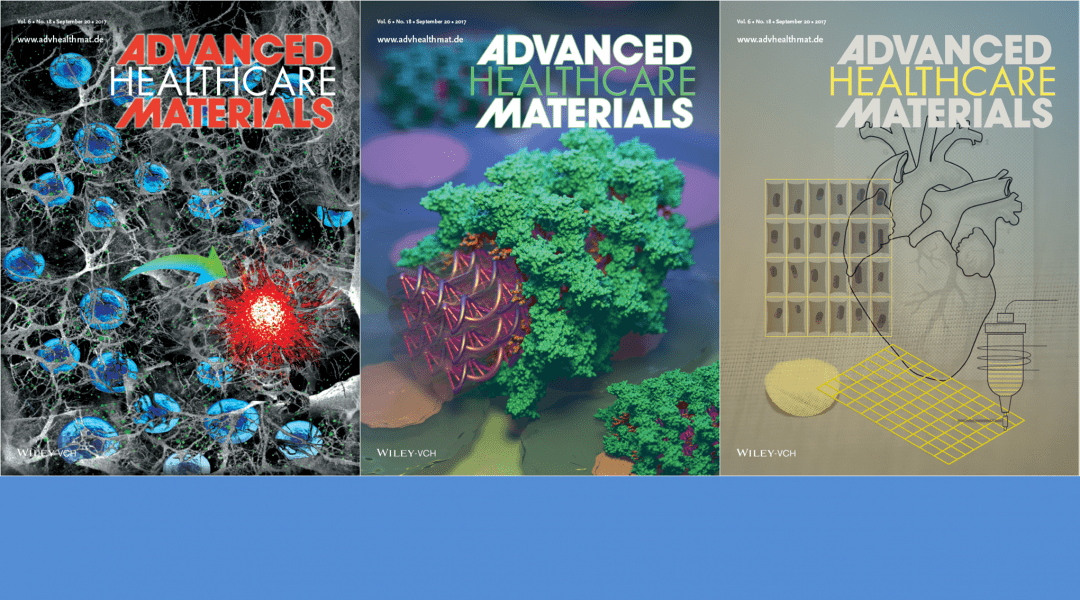Advanced Healthcare Materials celebrates its 5th birthday this year! Since 2012 we have been bringing you the latest breakthroughs in biomedical materials science with a strong focus on improving human health, and we will continue to do so in 2017. We therefore have launched virtual issues on five hot topics in the field, where you can access some of our best recent papers free of charge!
No access to our published content yet? Make sure to recommend Advanced Healthcare Materials to your librarian. More information can be found here.
In this biweekly feature, we highlight the artwork on the covers of the most recent issue of Advanced Healthcare Materials, and of course the research behind it. You can find this week’s issue here. Click on the titles or cover images below to get to the corresponding papers. Also check out our monthly Most Read.
Protein Coating of DNA Nanostructures for Enhanced Stability and Immunocompatibility
Coating of DNA Nanostructures for Enhanced Stability and Immunocompatibility
by Henni Auvinen, Hongbo Zhang, Nonappa, Alisa Kopilow, Elina H. Niemelä, Sami Nummelin, Alexandra Correia, Hélder A. Santos, Veikko Linko, and Mauri A. Kostiainen
Mauri Kostiainen and Veikko Linko at Aalto University and their co-workers across Finland present a straightforward and modular coating strategy that can bring DNA origami-based drug delivery vehicles and nanodevices closer to clinical applications. DNA origami nanostructures (the purple double helices in the image) can be coated with serum albumin proteins (green) to improve origami stability against DNA-digesting enzymes, enhance delivery rates and, importantly, suppress the immune response.
by Miguel Castilho, Dries Feyen, María Flandes-Iparraguirre, Gernot Hochleitner, Jürgen Groll, Pieter A. F. Doevendans, Tina Vermonden, Keita Ito, Joost P. G. Sluijter, and Jos Malda
Current limitations in cardiac tissue engineering revolve around the inability to fully recapitulate the structural organization and mechanical environment of native cardiac tissue. Jos Malda, Joost Sluijter, and Miguel Castilho at the University Medical Center Utrecht, and their co-workers in the Netherlands and Germany have developed organized scaffolds of ultrafine hydroxyl-functionalized polyester fibers that can guide the growth of cardiac cells and improve their mechanical anisotropy.
Controlled Exposure of Bioactive Growth Factor in 3D Amyloid Hydrogel for Stem Cells Differentiation
Exposure of Bioactive Growth Factor in 3D Amyloid Hydrogel for Stem Cells Differentiation
by Subhadeep Das, Rakesh Kumar, Narendra Nath Jha, and Samir K. Maji
Samir Maji and colleagues from the Indian Institute of Technology Bombay present an amyloid hydrogel for sustained delivery of growth factors for tissue engineering applications. The image represents stem cells (blue spheres) embedded within the hydrogel matrix (grey network) encapsulating growth factors (green dots). Within such a 3D cell culture, stem cells can promote and self-organize into spheroids (red sphere) with upregulated neuronal gene expression, so-called neurospheres, under the influence of the entrapped growth factors and the surface properties of the amyloid hydrogel.
Interested in more news about Advanced Healthcare Materials? Also check out our monthly Most Read.
We recently have released a top-level special issue on biomimetic interfaces in biomedical devices.
Discover our new virtual issues now too and read selected articles on nanotherapeutics, regenerative medicine, biofabrication, stem cells, and diagnostic devices for free.


 Electrospinning Writing of Poly-Hydroxymethylglycolide-co-ε-Caprolactone-Based Scaffolds for Cardiac Tissue Engineering
Electrospinning Writing of Poly-Hydroxymethylglycolide-co-ε-Caprolactone-Based Scaffolds for Cardiac Tissue Engineering














